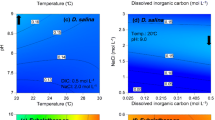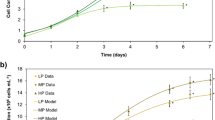Abstract
To overcome the contamination in open pond, microalgal strain selection should focus on species with tolerability to extreme environments. In this study, a native alkaliphilic algae, diatom Nitzschia plea was obtained in Southeast of China, which could tolerate high concentration of NaHCO3 (0.15 mol/L) and high pH (> 10). The effects of initial pH, light intensity and temperature on cell growth, biochemical composition and fatty acid profile of N. plea were investigated. Results indicated its specific growth rate could reach 1.2 day−1, lipid content was in the range 14.6–30.2% of dry weight, eicosapntemacnioc acid (EPA, C20:5) accounted for around 15% of total fatty acids. Alkalic condition benefited for both cell growth and EPA synthesis. Appropriately increasing light intensity and temperature could improve cell growth rate and lipid synthesis, although the proportion of EPA in total fatty acids decreased slightly. The optimal culture condition (pH 9.00, temperature 35.0 °C, light intensity 158.6 µmol/m2s) was suggested for maximum yield of EPA based on the response surface model. The overall biomass productivity and EPA productivity were 0.301 g/L/day and 7.43 mg/L/day, respectively. In conclusion, alkalic environment was helpful for the steady operation of open pond cultivation of N. plea with the characteristics of fast growth rate and high EPA content, which exhibited its commercial value.






Similar content being viewed by others
References
Klok AJ, Lamers PP, Martens DE, Draaisma RB, Wijffels RH (2014) Edible oils from microalgae: insights in TAG accumulation. Trends Biotechnol 32(10):521–528
Stephens E, Ross IL, Mussgnug JH, Wagner LD, Borowitzka MA, Posten C, Kruse O, Hankamer B (2010) Future prospects of microalgal biofuel production systems. Trends Plant Sci 15(10):554–564
Schenk PM, Thomas-Hall SR, Stephens E, Marx UC, Mussgnug JH, Posten C, Kruse O, Hankamer B (2008) Second generation biofuels: high-efficiency microalgae for biodiesel production. Bioenergy Res 1(1):20–43
de Godos I, Mendoza JL, Acien FG, Molina E, Banks CJ, Heaven S, Rogalla F (2014) Evaluation of carbon dioxide mass transfer in raceway reactors for microalgae culture using flue gases. Bioresour Technol 153:307–314
Pulz O, Gross W (2004) Valuable products from biotechnology of microalgae. Appl Microbiol Biotechnol 65(6):635–648
Richmond A, Karg S, Boussiba S (1982) Effects of bicarbonate and carbonate and carbon dioxide on the competition between Chlorella vulgaris and Spriulina platensis. Plant Cell Physiol 23(8):1411–1417
Bao Y, Liu M, Wu X, Cong W, Ning Z (2012) In situ carbon supplementation in large-scale cultivations of Spirulina platensis in open raceway pond. Biotechnol Bioprocess Eng 17(1):93–99
Raja R, Hemaiswarya S, Rengasamy R (2007) Exploitation of Dunaliella for beta-carotene production. Appl Microbiol Biotechnol 74(3):517–523
Wang B, Li Y, Wu N, Lan CQ (2008) CO2 bio-mitigation using microalgae. Appl Microbiol Biotechnol 79(5):707–718
Chi Z, O’Fallon JV, Chen S (2011) Bicarbonate produced from carbon capture for algae culture. Trends Biotechnol 29(11):537–541
Jones BE, Grant WD, Duckworth AW, Owenson GG (1998) Microbial diversity of soda lakes. Extremophiles 2(3):191–200
Lopez-Archilla AI, Moreira D, Lopez-Garcia P, Guerrero C (2004) Phytoplankton diversity and cyanobacterial dominance in a hypereutrophic shallow lake with biologically produced alkaline pH. Extremophiles 8(2):109–115
Chi Z, Xie Y, Elloy F, Zheng Y, Hu Y, Chen S (2013) Bicarbonate-based integrated carbon capture and algae production system with alkalihalophilic cyanobacterium. Bioresour Technol 133:513–521
Spolaore P, Joannis-Cassan C, Duran E, Isambert A (2006) Commercial applications of microalgae. J Biosci Bioeng 101(2):87–96
Stanier RY, Kunisawa R, Mandel M, Cohenbaz G (1971) Purification and properties of unicellular blue–green algae (Order Cchroococcales). Bacteriol Rev 35(2):171
Cheng J, Feng J, Sun J, Huang Y, Zhou J, Cen K (2014) Enhancing the lipid content of the diatom Nitzschia sp. by 60Co-γ irradiation mutation and high-salinity domestication. Energy 78:9–15
Kirrolia A, Bishnoi NR, Singh R (2013) Response surface methodology as a decision-making tool for optimization of culture conditions of green microalgae Chlorella spp. for biodiesel production. Ann Microbiol 64(3):1133–1147
Lowry OH, Rosebrough NJ, Farr AL, Randall RJ (1951) Protein measurement with the Folin phenol reagent. J Bio Chem 193(1):265–275
Dubois M, Gilles KA, Hamilton JK, Rebers PA, Smith F (1956) Colorimetric method for determination of sugars and related substances. Anal Chem 28(3):350–356
Bligh EG, Dyer WJ (1959) A rapid method of total lipid extraction and purification. Can J Biochem Physiol 37(8):911–917
Sun Z, Zhang D, Yan C, Cong W, Lu Y (2015) Promotion of microalgal biomass production and efficient use of CO2 from flue gas by monoethanolamine. J Chem Technol Biot 90(4):730–738
Sanchez-Luna LD, Bezerra RP, Matsudo MC, Sato S, Converti A, de Carvalho JC (2007) Influence of pH, temperature, and urea molar flowrate on Arthrospira platensis fed-batch cultivation: a kinetic and thermodynamic approach. Biotechnol Bioeng 96(4):702–711
Jiang Y, Yoshida T, Quigg A (2012) Photosynthetic performance, lipid production and biomass composition in response to nitrogen limitation in marine microalgae. Plant Physiol Biochem: PPB/Societe francaise de physiologie vegetale 54:70–77
Kurpan Nogueira DP, Silva AF, Araújo OQF, Chaloub RM (2015) Impact of temperature and light intensity on triacylglycerol accumulation in marine microalgae. Biomass Bioenergy 72:280–287
Sukenik A, Carmeli Y, Berner T (1989) Regulation of fatty-acid composition by irradiance level in the eustigmatophyte Nannochloropsis sp. J Phycol 25(4):686–692
Berner T, Dubinsky Z, Wyman K, Falkowski PG (1989) Photoadaption and the pakage effect in Dunaliella tertiolecta (Chlorophyceae). J Phycol 25(1):70–78
Hosono H, Uemura I, Takumi T, Nagamune T, Yasuda T, Kishimoto M, Nagashima H, Shimomura N, Natori M, Endo I (1994) Effect of culture temperature shift on the cellular sugar accumulation of Chlorella vulgaris SO-26. J Biosci Bioeng 78(3):235–240
Henderson RJ, Mackinlay EE (1989) Effect of temperature on lipid composition of the marine cryptomonad Chroomonas salina. Phytochemistry 28(11):2943–2948
Renuad SM, Zhou HC, Parry DL, Think L-V, Woo KC (1995) Effect of temperature on the growth, total lipid content and fatty acid composition of recently isolated tropical microalgae Isochrysis sp., Nitzschia closterium, Nitzschia paleacea, and commerical species Isochrysis sp.(clone T. ISO). J Appl Phycol 7:595–602
Cybulski LE, Albanesi D, Mansilla MC, Altabe S, Aguilar PS, De Mendoza D (2002) Mechanism of membrane fluidity optimization: isothermal control of the Bacillus subtilis acyl-lipid desaturase. Mol Microbiol 45(5):1379–1388
Jiang Y, Laverty KS, Brown J, Nunez M, Brown L, Chagoya J, Burow M, Quigg A (2014) Effects of fluctuating temperature and silicate supply on the growth, biochemical composition and lipid accumulation of Nitzschia sp. Bioresour Technol 154:336–344
Jiang Y, Nunez M, Laverty KS, Quigg A (2014) Coupled effect of silicate and nickel on the growth and lipid production in the diatom Nitzschia perspicua. J Appl Phycol 27(3):1137–1148
Xue SZ, Su ZF, Cong W (2011) Growth of Spirulina platensis enhanced under intermittent illumination. J Biotechnol 151(3):271–277
Simionato D, Block MA, La Rocca N, Jouhet J, Maréchal E, Finazzi G, Morosinotto T (2013) The Response of Nannochloropsis gaditana to nitrogen starvation includes de novo biosynthesis of triacylglycerols, a decrease of chloroplast galactolipids, and reorganization of the photosynthetic apparatus. Eukaryot Cell 12(5):665–676
Acknowledgements
This study was supported by National Key R&D Program of China (2016YF0601005).
Author information
Authors and Affiliations
Corresponding author
Rights and permissions
About this article
Cite this article
Zhang, D., Wen, S., Wu, X. et al. Effect of culture condition on the growth, biochemical composition and EPA production of alkaliphilic Nitzschia plea isolated in the Southeast of China. Bioprocess Biosyst Eng 41, 831–839 (2018). https://doi.org/10.1007/s00449-018-1917-0
Received:
Accepted:
Published:
Issue Date:
DOI: https://doi.org/10.1007/s00449-018-1917-0




